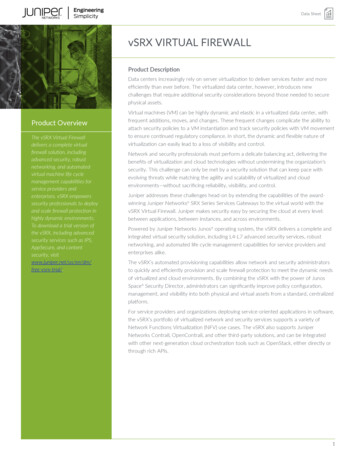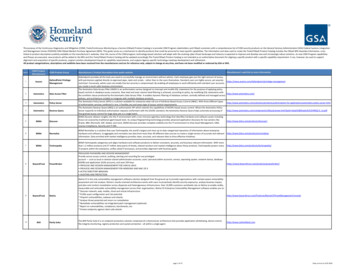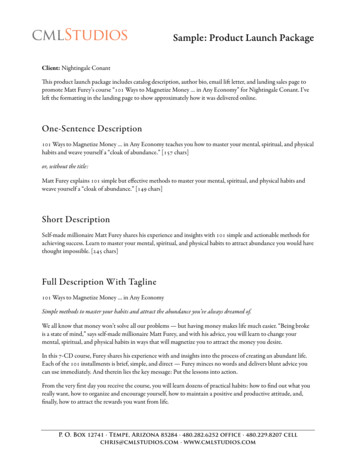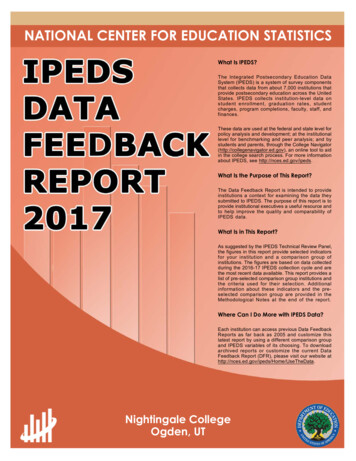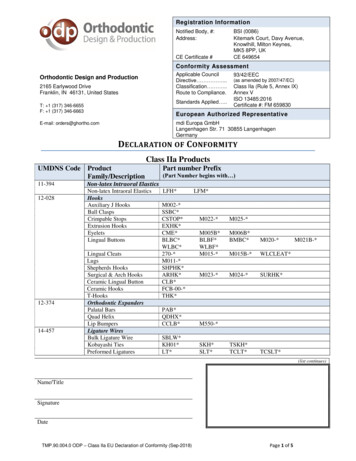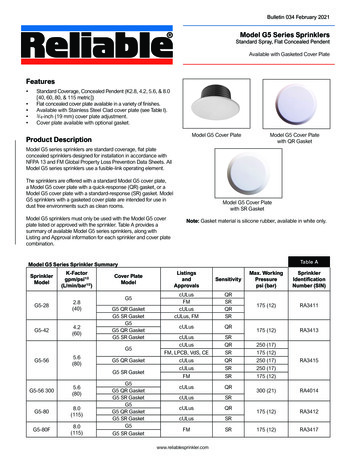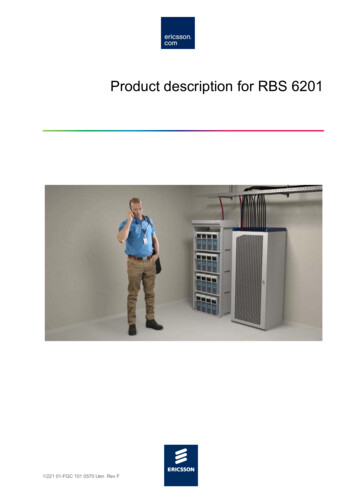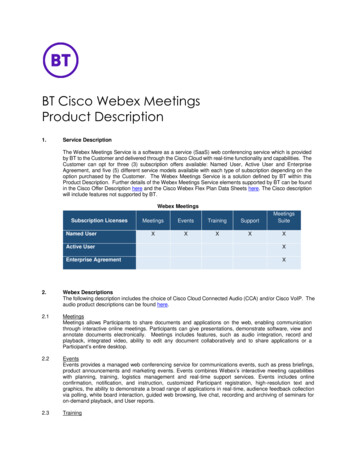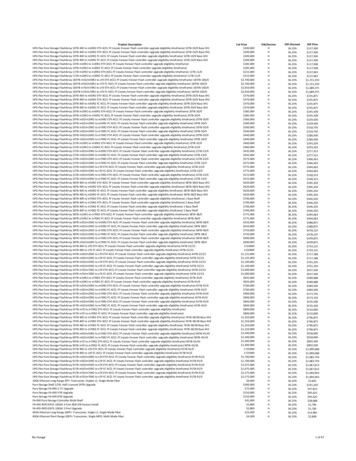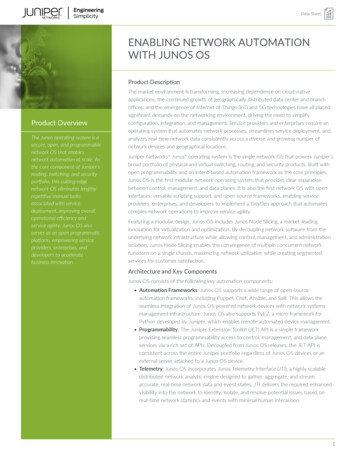
Transcription
Data SheetENABLING NETWORK AUTOMATIONWITH JUNOS OSProduct DescriptionProduct OverviewThe Junos operating system is asecure, open, and programmablenetwork OS that enablesnetwork automation at scale. Asthe core component of Juniper’srouting, switching, and securityportfolio, this cutting-edgenetwork OS eliminates lengthyrepetitive manual tasksassociated with servicedeployment, improving overalloperational efficiency andservice agility. Junos OS alsoserves as an open programmaticplatform, empowering serviceproviders, enterprises, anddevelopers to acceleratebusiness innovation.The market environment is transforming. Increasing dependence on cloud-nativeapplications, the continued growth of geographically distributed data center and branchoffices, and the emergence of Internet of Things (IoT) and 5G technologies have all placedsignificant demands on the networking environment, driving the need to simplifyconfiguration, integration, and management. Service providers and enterprises require anoperating system that automates network processes, streamlines service deployment, andanalyzes real-time network data consistently across a diverse and growing number ofnetwork devices and geographical locations.Juniper Networks Junos operating system is the single network OS that powers Juniper’sbroad portfolio of physical and virtual switching, routing, and security products. Built withopen programmability and an intent-based automation framework as the core principles,Junos OS is the first modular network operating system that provides clear separationbetween control, management, and data planes. It is also the first network OS with openinterfaces, versatile scripting support, and open-source frameworks, enabling serviceproviders, enterprises, and developers to implement a DevOps approach that automatescomplex network operations to improve service agility.Featuring a modular design, Junos OS includes Junos Node Slicing, a market-leadinginnovation for virtualization and optimization. By decoupling network software from theunderlying network infrastructure while allowing control, management, and administrationisolation, Junos Node Slicing enables the convergence of multiple concurrent networkfunctions on a single chassis, maximizing network utilization while creating segmentedservices for customer satisfaction.Architecture and Key ComponentsJunos OS consists of the following key automation components: Automation Frameworks: Junos OS supports a wide range of open-sourceautomation frameworks, including Puppet, Chef, Ansible, and Salt. This allows theseamless integration of Junos OS-powered network devices with network systemsmanagement infrastructure. Junos OS also supports PyEZ, a micro framework forPython developed by Juniper, which enables remote automated device management. Programmability: The Juniper Extension Toolkit (JET) API is a simple frameworkproviding seamless programmability access to control, management, and data planeservices via a rich set of APIs. Decoupled from Junos OS releases, the JET API isconsistent across the entire Juniper portfolio regardless of Junos OS devices or anexternal server attached to a Junos OS device. Telemetry: Junos OS incorporates Junos Telemetry Interface (JTI), a highly scalabledistributed network analytic engine designed to gather, aggregate, and streamaccurate, real-time network data and event states. JTI delivers the required enhancedvisibility into the network to identify, isolate, and resolve potential issues based onreal-time network statistics and events with minimal human interaction.1
Enabling Network Automation with Junos OSFigure 1: Disaggregated Junos OS software Open Data Models: Since its inception, Junos OS has beenmodeling the configuration and operational state internallyusing what was effectively the precursor of YANG.What JunosOS pioneered has effectively become the industry standard,where Network Configuration Protocol (NETCONF) is used asa transport mechanism, while YANG is used as a data-modelinglanguage. In addition to supporting YANG to modelconfiguration objects, Junos OS also supports the standardizedYANG models and OpenConfig. Junos Continuity: A major cause of downtime is the need toupgrade the network OS whenever new hardware, such as aline card, is installed in a device. These upgrades and thesubsequent reboot always impact existing services. JunosContinuity provides a plug-and-play approach that ensureshigh network availability, preventing required device rebootsby making the insertion of new line cards a non-serviceimpacting event. Junos Node Slicing: Junos Node Slicing supports theconvergence of multiple concurrent network functions on thesame physical infrastructure. This gives service providers theability to optimize their infrastructure, while offeringdifferentiated services with enhanced operational andadministrative isolation with a single chassis. By decoupling thenetwork software from underlying infrastructure, Junos NodeSlicing accelerates service deployment, reduces capital outlay,and improves operational efficiency.Features and BenefitsRevenue GrowthThe programmability and automation capabilities of Junos OS giveservice providers and enterprises the ability to automate businesscritical services. This frees up valuable resources for innovation andoptimal user experiences, which ultimately leads to greatercustomer satisfaction and brand loyalty. Junos Node Slicingoptimizes the network infrastructure, enabling the convergence ofmultiple concurrent network functions on a single chassis,dramatically improving operational efficiency and top-line growthopportunities.Cost EfficienciesJunos OS improves the overall cost efficiency of networkdeployments. Junos Node Slicing enables the convergence ofmultiple concurrent network functions with a single chassis,maximizing the utilization of network nodes and improving CapExefficiency. OpEx efficiency is achieved through automation, whichreplaces the extensive manual processes required by traditionalnetwork configuration, management, and operation, drasticallysimplifying network operations and virtually eliminating humanerrors.AgilityBusiness requirements are always evolving, reflecting constantlychanging market dynamics. The programmability and open-sourceautomation frameworks supported by Junos OS give serviceproviders and enterprises the ability to rapidly implementcustomized network services and deploy business-criticalapplications.2
Enabling Network Automation with Junos OSFeaturesBenefitsJunos Node SlicingConverges multiple concurrent network functions on a single chassis to accelerate service deployment, reduce capital outlay, and improveoperational efficiency.Seamless integration with a wide range of opensource automation frameworksEnables implementation of a DevOps approach to automate complex network operations and business- critical services.Juniper Extension Toolkit (JET) APIOffers a simple and programmable framework that provides open access to control, management, and data planes.Junos Telemetry Interface (JTI) scalabledistributed network analytic engineStreams accurate real-time network data, providing service assurance with enhanced visibility to identify, isolate, and resolve potentialissues based on real-time network statistics and events with minimal human interaction.Junos ContinuityMakes adding new hardware a plug-and-play, non-service impacting event, eliminating device reboots during network updates.High AvailabilityJunos Automation ScriptsJunos OS supports high availability (HA), enabling service providersand enterprises to avoid extended maintenance windows andprolonged service impacts. Junos Continuity eliminates the devicereboot and network OS upgrade typically required during theinstallation of new hardware such as line cards. Junos SelectiveUpdate allows users to apply a patch (hotfix) on an installed versionof Junos OS running on a Juniper device without any servicedisruption.Junos Automation Scripts consist of:Superior PerformanceFast Programmatic Configuration (eDB)By supporting full symmetric multiprocessing (SMP), Junos OSenables the operating system to utilize all CPU cores on theRouting Engine. The result is a flexible, scalable, and powerfulnetwork infrastructure with the multicore capabilities of thenetworking devices.A fast, ultra-low-latency database for programmatic configuration,eDB resides on Junos OS to help with programmatic changes thatare verified and monitored externally. SDN controllers and externalapplications alike can benefit from this fast channel to make controland data plane configuration changes on devices running Junos OS.SecuritygRPCJunos OS incorporates many advanced security features thatminimize network vulnerability. The Secure Boot feature certifiesthat Junos OS devices boot with only an authentic, untamperedversion of the Junos OS. It also ensures that devices boot an imagethat has not been tampered with. The built-in security featuresprovide a secured and trusted chain of software development,safeguarding device integrity from factory to the branch site.General-purpose remote procedure call (gRPC) is an open- source,SpecificationsJunos OS encompass a comprehensive set of automation featuresand support for open-source framework and standard protocols.Automation features and open-source support are available acrossJuniper’s product portfolio, including the Juniper Networks MXSeries 3D Universal Edge Routers, PTX Series Packet TransportRouters, ACX Series Universal Access Routers, EX Series EthernetSwitches, QFX Series Switches, SRX Series Services Gateways, andT Series Core Routers. Op-Scripts: Used to perform operational tasks on demand Event-Scripts: Used to instruct Junos OS to perform actions inresponse to system events Commit-Scripts: Used to instruct Junos OS to perform actionsat or during commit time SNMP Scripts: Provide the flexibility needed to supportcustom MIBsBSD-licensed HTTP/2 RPC framework developed and used byGoogle to handle remote procedure calls. gRPC enables the easycreation of high-performance, scalable APIs and microservices inmany popular programming languages and platforms.HTTP(s)HTTP is a protocol used for communication, usually with Internetresources or any application with a Web browser client. HTTPsenables communication over an encrypted connection.Juniper Extension ToolkitThe Juniper Extension Toolkit (JET) is a next-generation solutionthat makes programming Junos OS simple, flexible, and extensible.JET is based on four fundamental components: JET APIs, Python,JavaScript Object Notation (JSON), and Fast ProgrammaticConfiguration (or eDB).JET APIsJET offers a set of APIs that are consistent across any Junos OSsupporting JET. JET APIs are language-agnostic and can beaccessed by any programming language. Applications developedusing JET APIs are also binary-compatible and can be executedacross any platform running a Junos OS release supporting JET.3
Enabling Network Automation with Junos OSJunos Snapshot Administrator (JSNAP)Junos Snapshot Administrator captures and audits the runtimeenvironment of network devices running Junos OS, automatingnetwork state verification by capturing and validating the status of adevice. It is used to take pre- and post-snapshots of theenvironment, then compare them based on test cases provided. It isalso used to audit a device’s runtime environment againstpredefined criteria. JSNAP is the Stylesheet Language AlternativeSyntax (SLAX) version of the tool.JSNAP using Python (JSNAPy)JSNAPy is the Python version of the JSNAP tool described above.JavaScript Object Notation (JSON)JSON is a popular data exchange format which has become astandard for simple and lightweight communication betweendevices and applications. To enrich native support in severalprogramming languages, Junos OS operational commands can emitoutput in JSON format. Junos OS configuration input can also beprovided in JSON format.Junos Telemetry InterfaceOpenConfigOpenConfig is an informal working group of network operators thatis focused on compiling a consistent set of vendor-neutral datamodels (written in YANG) based on actual operational needs fromuse cases and requirements from multiple network operators.PyEZJunos PyEZ is a Python “micro-framework” used to remotelymanage or automate a device running Junos OS.PythonWith native support for Python in Junos OS, users can develop andexecute operational, event, and configuration commit scripts usingPython.Representational State Transfer (REST) APIThe Junos OS REST API is an interface that enables users tosecurely connect to Junos OS devices and execute remoteprocedure calls. Using the REST API Explorer GUI, users canconveniently experiment with any REST API and explore a varietyof formatting and display options, including JavaScript ObjectNotation (JSON). REST uses HTTP as its application- layer protocol.The Junos Telemetry Interface (JTI) is a high-frequency telemetryexport function available on Juniper networking platforms tooptimize network performance and fault management.RubyEZJunos User Interface Scripting EnvironmentStylesheet Language Alternative SyntaxThe Junos User Interface Scripting Environment (JUISE) is a set oftools that allows the development and testing of SLAX scriptstargeting devices running Junos OS. Users can develop scripts intheir own desktop environment, performing the necessary code,test, and debug cycles in a more familiar setting. Tools fordevelopers are available, including a debugger, a profiler, a call- flowtracing mechanism, and trace files.SLAX is a language for writing Junos OS Op Scripts, Event Scripts,Commit Scripts, and SNMP Scripts.JxmleaseJxmlease is a Python module that converts XML to intelligentPython data structures, and vice versa.NETCONFNETCONF is a protocol defined by the IETF for installing,manipulating, and deleting network device configurations.NETCONF LibrariesNETCONF libraries support XML-based data encoding, SSHtransport, and
The Junos operating system is a secure, open, and programmable network OS that enables network automation at scale. As the core component of Juniper’s routing, switching, and security portfolio, this cutting-edge network OS eliminates lengthy repetitive manual tasks associated with service deployment, improving overall operational efficiency and service agility. Junos OS also serves as an .
